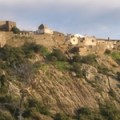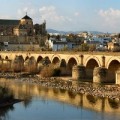Jaen City, northern Andalucia
Set in northern Andalucia, the city of Jaen has a rich history with fascinating architecture. The oldest part of the city is dominated by the Arab fortress.
Castillo de Santa Catalina
This is truly a castle among olive trees and its position allows visitors fabulous views of the city of Jaen and the rolling olive groves.
The castle stands on top of mount Santa Catalina. Over the years 3 different fortresses were built on the site, giving way to the existing castle.
There are still remains of one of those old fortresses: Hannibal’s Tower. The most notable feature of this castle, which is connected by a passage to the city of Jaen, is the Cross Viewpoint, from where some fantastic views open up.
At its feet, the oldest districts of the city unfold.
Every year the citys’ squares are taken over by huge bonfires and festivities to celebrate the patron saint and protector of animals San Antonio Abad.
The towns neighbourhoods or barrios compete against each other as to who can build the biggest and most spectacular bonfire. It is here that the inhabitants perform the traditional dance called “Los Melenchones” .
Catedral de Jaen
This monumental building can be found in the historic quarter of the city. Dedicated to the Assumption of the Virgin, the temple was built over the old mosque, in the times of Fernando III the Saint. However, in the 15th century, construction of the Gothic sanctuary was begun to house the Holy Face. This sanctuary houses the cloth of the Holy Face which, according to tradition, was used by Veronica to dampen the face of Christ.
The interior contains 17 chapels among which the main chapel was decorated by Juan de Aronda in the 17th century. The main façade of the cathedral is a massive tableau of stone, flanked by two towers 26 metres in height which dwarf the city.
Palacio de Villardom Pardo
As you continue your tour you will be impressed by Jaens civil architecture, with its dozens of churches and chapels mostly situated in beautiful Plazas with sprinkling fountains.
A true gem is the Palacio de Villardom Pardo, today the Provincial Council Building.
This palace was built in 1592 on the orders of Fernando de Torres y Portugal former viceroy of Peru.
Under the palace are hidden some 10th century Arab baths. They are called the Ali baths and are considered to be the best preserved in Andalucia. They were discovered in 1913 and declared a national monument in 1917, and a historic-artistic monument in 1931. They were an important place for personal hygiene but also for social life. The structure has four rooms: the marble lobby with red and white arches, followed by the cold room, the warm and hot rooms.
Today it houses the museum of Naïf Art and the museum of Popular Arts and customs.



